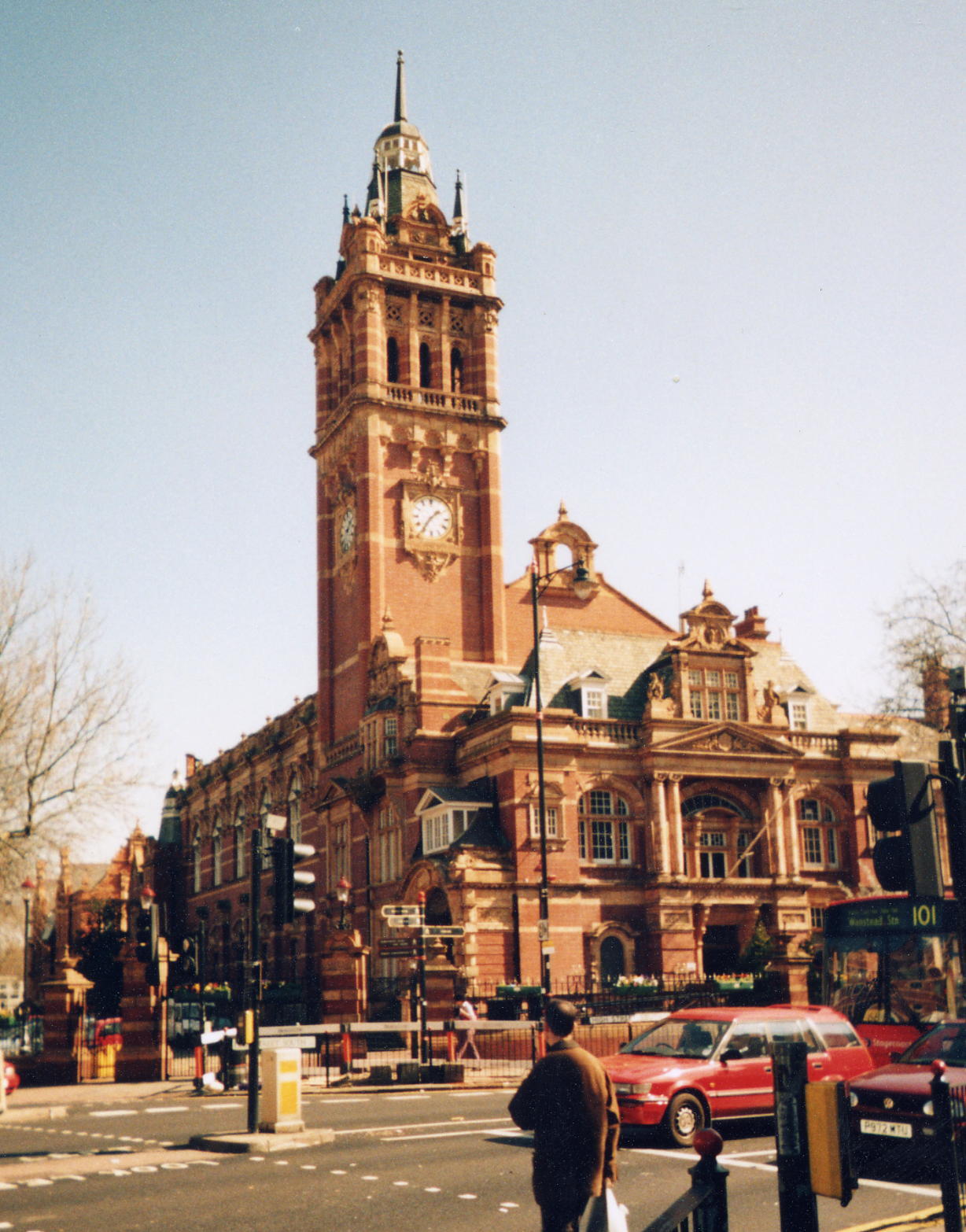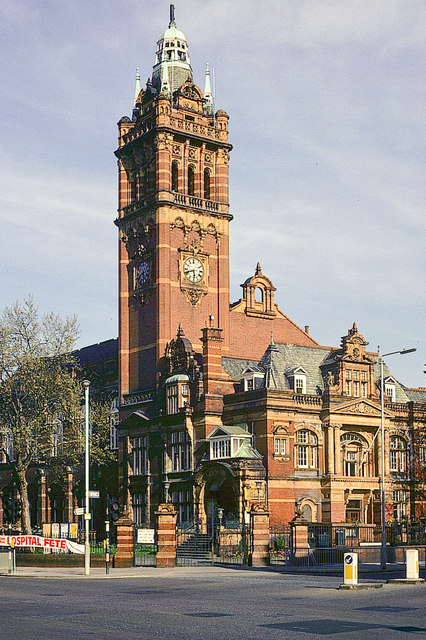|
London Borough Of Newham
The London Borough of Newham () is a London borough created in 1965 by the London Government Act 1963. It covers an area previously administered by the Essex county boroughs of West Ham and East Ham, authorities that were both abolished by the same act. The name Newham reflects its creation and combines the compass points of the old borough names. Situated in the Inner London part of East London, Newham has a population of 387,576, which is the fourth highest of the London boroughs and also makes it the 25th most populous district in England. The local authority is Newham London Borough Council. It is east of the City of London, north of the River Thames (the Woolwich Ferry and Woolwich foot tunnel providing the only crossings to the south), bounded by the River Lea to its west and the North Circular Road to its east. Newham was one of the six host boroughs for the 2012 Summer Olympics and contains most of the Olympic Park including the London Stadium, and also cont ... [...More Info...] [...Related Items...] OR: [Wikipedia] [Google] [Baidu] |
London Boroughs
The London boroughs are the current 32 local authority districts that together with the City of London make up the administrative area of Greater London, England; each is governed by a London borough council. The present London boroughs were all created at the same time as Greater London on 1 April 1965 by the London Government Act 1963 (c. 33) and are a type of local government district. Twelve were designated as Inner London boroughs and twenty as Outer London boroughs. The City of London, the historic centre, is a separate ceremonial county and local government district that functions quite differently from a London borough. However, the two counties together comprise the administrative area of Greater London as well as the London Region, all of which is also governed by the Greater London Authority, under the Mayor of London. The London boroughs have populations of between 150,000 and 400,000. Inner London boroughs tend to be smaller, in both population and area, an ... [...More Info...] [...Related Items...] OR: [Wikipedia] [Google] [Baidu] |
List Of English Districts By Population
This is a list of the districts of England ordered by population, according to estimated figures for from the Office for National Statistics. The list consists of 164 non-metropolitan districts, 32 London boroughs, 36 metropolitan boroughs, 62 unitary authorities, and two ''sui generis'' authorities (the City of London and the Isles of Scilly). {{#invoke: AutosortTable , create , class = wikitable plainrowheaders sortable sticky-header-multi , separator = -- , order = 1 , numeric = 1 , caption= English districts by population ({{English statistics year) , rowheader = 1 , header = -- Rank -- District -- Population -- Type -- Ceremonial county -- Region , -- {{cardinal, {{English district rank, GSS=E07000223 -- Adur -- {{English district population, GSS=E07000223 -- Non-metropolitan district -- West Sussex -- South East , -- {{cardinal, {{English district rank, GSS=E07000032 -- Amber Valley -- {{English district population, GSS=E07000032 -- Non-metropolitan d ... [...More Info...] [...Related Items...] OR: [Wikipedia] [Google] [Baidu] |
Inner London
Inner London is the group of London boroughs that form the interior part of Greater London and are surrounded by Outer London. With its origins in the bills of mortality, it became fixed as an area for statistics in 1847 and was used as an area of local government from 1855 to 1965 principally as the County of London or earlier as the Metropolitan Board of Works Area (metropolis). It now has two common definitions. The first is the statutory definition delineated in the London Government Act 1963, coming into force on 1 April 1965, comprising twelve Inner London boroughs and almost identical to the County of London that was abolished at the same time. The second is the definition used by the Office for National Statistics comprising eleven of the statutory Inner London boroughs and two of the statutory Outer London boroughs, as well as the City of London. [...More Info...] [...Related Items...] OR: [Wikipedia] [Google] [Baidu] |
County Borough Of East Ham
East Ham was a local government district in the far south west of Essex from 1878 to 1965. It extended from Wanstead Flats in the north to the River Thames in the south and from Green Street, London, Green Street in the west to Barking Creek in the east. It was part of the London postal district and Metropolitan Police District. Local board and urban district East Ham Local Government District was created in 1878, when the parish of East Ham adopted the Local Government Act 1858, and formed a local board of health, local board of nine members to govern the area. In 1886 the local government district was extended to include the civil parish of Little Ilford, and the board was increased to 12 in number. The Local Government Act 1894 reconstituted the area as an Urban district (Great Britain and Ireland), urban district, with an elected urban district council of 15 members replacing the board. In 1900 Little Ilford parish was abolished and its area absorbed into an enlarged East Ham. ... [...More Info...] [...Related Items...] OR: [Wikipedia] [Google] [Baidu] |
County Borough Of West Ham
West Ham was a local government district in the extreme south west of Essex from 1886 to 1965, forming part of the built-up area of London, although outside the County of London. It was immediately north of the River Thames and east of the River Lea. Area and boundaries The borough included Plaistow, West Ham, Stratford, Canning Town and Silvertown – all of the current-day London Borough of Newham west of Green Street. At the time of the 1901 census it was the ninth most populous town or district in England with a population of 267,308. The borough formed part of London's built-up area, was part of the London postal district and the Metropolitan Police District. From 1934 to 1965 it was surrounded by the County Borough of East Ham to the east, the municipal boroughs of Wanstead and Woodford and Leyton to the north, and the metropolitan boroughs of Poplar and Hackney to the west and Greenwich to the south. Predecessors West Ham underwent rapid growth from 1844 fol ... [...More Info...] [...Related Items...] OR: [Wikipedia] [Google] [Baidu] |
Essex
Essex ( ) is a Ceremonial counties of England, ceremonial county in the East of England, and one of the home counties. It is bordered by Cambridgeshire and Suffolk to the north, the North Sea to the east, Kent across the Thames Estuary to the south, Greater London to the south-west, and Hertfordshire to the west. The largest settlement is Southend-on-Sea, and the county town is Chelmsford. The county has an area of and a population of 1,832,751. After Southend-on-Sea (182,305), the largest settlements are Colchester (130,245), Basildon (115,955) and Chelmsford (110,625). The south of the county is very densely populated, and the remainder, besides Colchester and Chelmsford, is largely rural. For local government purposes Essex comprises a non-metropolitan county, with twelve districts, and two unitary authority areas: Thurrock Council, Thurrock and Southend-on-Sea City Council, Southend-on-Sea. The districts of Chelmsford, Colchester and Southend have city status. The county H ... [...More Info...] [...Related Items...] OR: [Wikipedia] [Google] [Baidu] |
London Government Act 1963
The London Government Act 1963 (c. 33) is an act of the Parliament of the United Kingdom, which created Greater London and a new local government structure within it. The Act significantly reduced the number of local government districts in the area, resulting in local authorities responsible for larger areas and populations. The upper tier of local government was reformed to cover the whole of the Greater London area and with a more strategic role; and the split of functions between upper and lower tiers was recast. The Act classified the boroughs into inner and outer London groups. The City of London and its corporation were essentially unreformed by the legislation. Subsequent amendments to the Act have significantly amended the upper tier arrangements, with the Greater London Council abolished in 1986, and the Greater London Authority introduced in 2000. , the London boroughs are more or less identical to those created in 1965, although with some enhanced powers over service ... [...More Info...] [...Related Items...] OR: [Wikipedia] [Google] [Baidu] |
List Of Law Enforcement Agencies In The United Kingdom
There are a number of agencies that participate in law enforcement in the United Kingdom which can be grouped into three general types: * Territorial police forces, who carry out the majority of policing. These are police forces that cover a police area (a particular region) and have an independent police authority. Current police forces have their grounding in the Police Act 1996 (in England and Wales), a combination of Police (Scotland) Act 1967 and Police and Fire Reform (Scotland) Act 2012 (in Scotland) and the Police (Northern Ireland) Act 2000 (in Northern Ireland), which prescribe a number of issues such as appointment of a chief constable, jurisdiction and responsibilities. * National law enforcement bodies, including the National Crime Agency and national police forces that have a specific, non-regional jurisdiction, such as the British Transport Police. The Serious Organised Crime and Police Act 2005 refers to these as 'special police forces', not including the NCA whi ... [...More Info...] [...Related Items...] OR: [Wikipedia] [Google] [Baidu] |
GSS Coding System
GSS codes are nine-character geocodes maintained by the United Kingdom's Office for National Statistics (ONS) to represent a wide range of geographical areas of the UK, for use in tabulating census and other statistical data. GSS refers to the Government Statistical Service of which ONS is part. GSS codes replaced a previous system called ONS codes from January 2011. ONS codes were hierarchical whereas in GSS codes there is no relation between the code for a lower-tier area and the corresponding parent area. Code formulation GSS codes have a fixed length code of nine characters. The first three characters indicate the level of geography, and the six digits following define the individual unit. For example, the Royal Borough of Greenwich is coded as E09000011, Middlesbrough is E06000002, Cambridge E07000008 and Fenland E07000010. , the meanings of some common three character prefixes are as follows: In 2019, the House of Commons Library proposed names instead of numeric code ... [...More Info...] [...Related Items...] OR: [Wikipedia] [Google] [Baidu] |
ONS Coding System
The ONS coding system was a hierarchical code used in the United Kingdom for tabulating census and other statistical data. ONS refers to the Office for National Statistics. It was replaced by the GSS coding system on 1 January 2011. Code formulation Principal authorities The code was constructed top down from a four character code representing a unitary authority or two-tier county and district. Electoral wards and output areas Local government wards had a two-letter code within their local authority, and census output area an additional four digits within a ward. The authority and ward codes were recognised by Eurostat as local administrative unit code levels 1 and 2 within the NUTS system. Civil parishes An overlapping system encoded civil parish areas. Parishes were represented by an additional three digits within their local authority: List of codes for counties and districts The codes for counties and districts were as follows. Also showing NUTS(3) ... [...More Info...] [...Related Items...] OR: [Wikipedia] [Google] [Baidu] |

